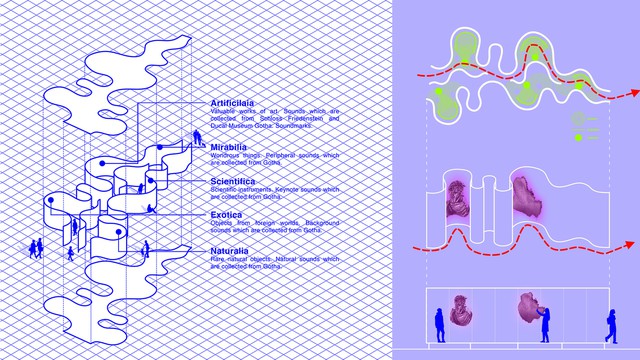Alter.ii 2022, Germany, Gotha
An audio reactive media architecture installation in the baroque heart of Gotha






With the intention of creating friction in the area to engage the public with the museums and palaces of Gotha, alter.ii aims to invite visitors to dive into a colourful atmosphere shaped by reflections of the baroque world. The project intends to create a memorable experience with its dynamic, loud, bright, altered and colourful space by combining architecture with audio-visual media installations. By taking inspiration from the concept of “Wunderkammer” or “Cabinet of curiosities”, many different categories of sounds have been collected from the city of Gotha and were visualised through light installations inside a specially designed pavilion space. Similar to the baroque interest in collecting interesting objects, organising and exhibiting these collections, the project “alter.ii” collects and exhibits the sounds of the city to connect the hidden baroque artefacts to our daily lives.
Alter.ii is an audio-reactive mediaarchitecture installation that aims to inspire visitors about the rich baroque world of Gotha. By taking inspiration from the concept of “Wunderkammer” or “Cabinet of curiosities”, many different categories of sounds have been collected from the city of Gotha and were visualised through light installations inside a specially designed pavilion space. Similar to the baroque interest in collecting interesting objects, organising and exhibiting these collections, the project “alter.ii” collects and exhibits the sounds of the city to connect the hidden baroque artefacts to our daily lives. The pavilion is designed to be built on the Schlosspark which provides a path from Gotha train station to Ducal Museum, Schloss Friedenstein and then the city centre. With the intention of creating friction in the area to engage the public with the museums and palaces of the city, alter.ii aims to invite visitors to dive into a colourful atmosphere shaped by reflections of the baroque world. The project intends to create a memorable experience with its dynamic, loud, bright, altered and colourful space by using not only visual senses but also auditory senses. By taking inspiration from the 5 different categories of “Wunderkammer”, 5 different soundscapes are created from collecting sounds of Gotha. These sounds are composed together in a collection, a soundscape that is directly connected to certain museum collection artefacts from the city. The selected museum objects are projected onto the walls of the pavilion in a dynamic movement by being transformed with the frequency differences from the soundscape. With the TouchDesigner program, the objects are made to react to audio frequencies with elongation, dispersion and colour changes. A special, multi-sensory atmosphere is created through sound, projection lights and reflection of the architectural elements. By inspiring visitors to learn more about the “Wunderkammer” and baroque, the pavilion gives short descriptions of selected objects and invites to discover more.
Poster
Details
Team members : Ipek Aydin, Idil Ozturk
Supervisor : Prof. Bernd Rudolf, Prof. Andreas Kästner, Junior Prof. Reinhard König, Dr. Sabine Zierold
Institution : Bauhaus University Weimar
Descriptions
Technical Concept : Alter.ii utilises the TouchDesigner programme for its audio-visual media installation. First, the collected sounds are composed together to create a conceptually cohesive audio file. Then this audio file is connected to the TouchDesigner programme to be analysed in 3 different levels of frequencies, which are bass sounds (<400 Hz), midrange sounds (400-2000 Hz) and high frequency sounds (>3000 Hz). Secondly, the 3d models of selected museum works which are part of Gotha “Wunderkammer” artefacts are transformed into point clouds. Finally, by coding movement to these point clouds, the objects are connected to the sound frequencies to react in real time. With the final rendering output, light, colour and movement all react to the sound collection of Gotha. These visual renderings are then projected inside the pavilion walls at the same time with the soundscape on the speakers.
Visual Concept : With its reflective material, the façade of the pavilion does not interrupt its surrounding park space. On the inside, the light installation is reflected and is engaging in a multisensory way. The wavy look of the space both works for the reflection effect and also reminds the visitor of the folds of the surrounding baroque architecture from a modern perspective. As the sound frequencies go higher, the visual renderings also change colour on the rainbow scale. The particle dispersion effect of the artefacts aims to create engagement with an object that cannot be touched. In the prototyped sectional projection trials, the reflection, colour and dispersion effects were a success.
Credits
Ipek Aydin, Idil Ozturk
Ipek Aydin, Idil Ozturk
Ipek Aydin, Idil Ozturk
Ipek Aydin, Idil Ozturk
Ipek Aydin, Idil Ozturk
Ipek Aydin, Idil Ozturk
Ipek Aydin, Idil Ozturk